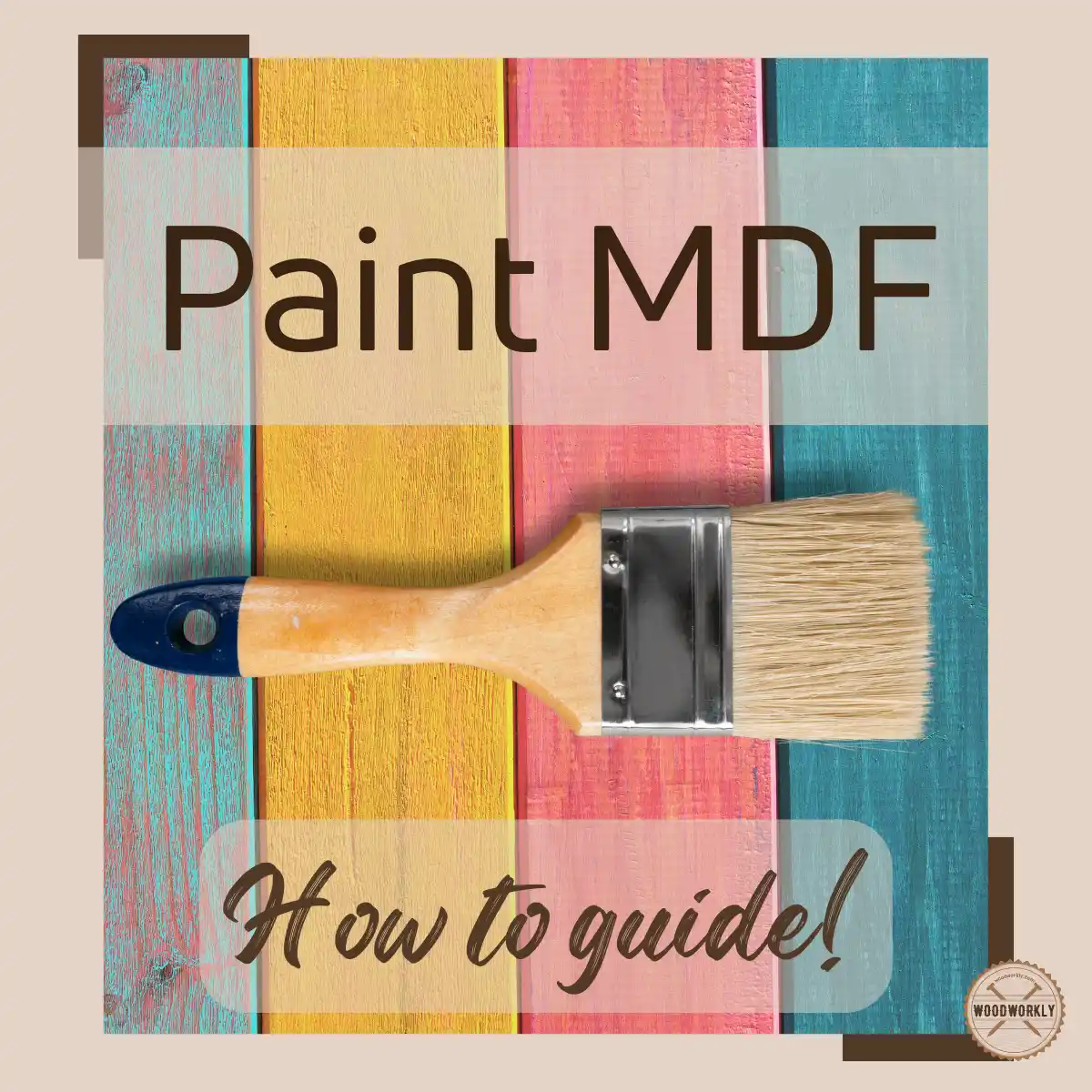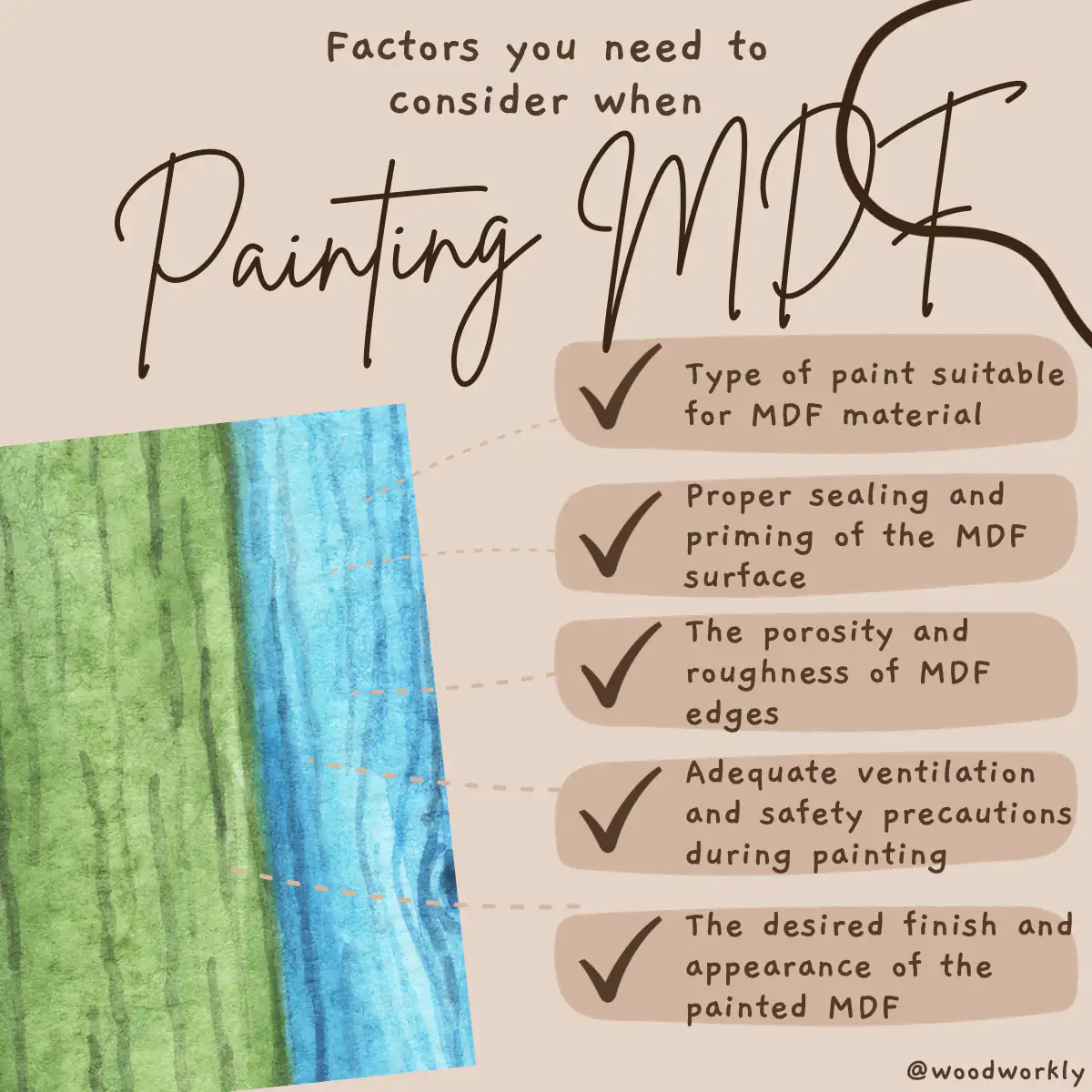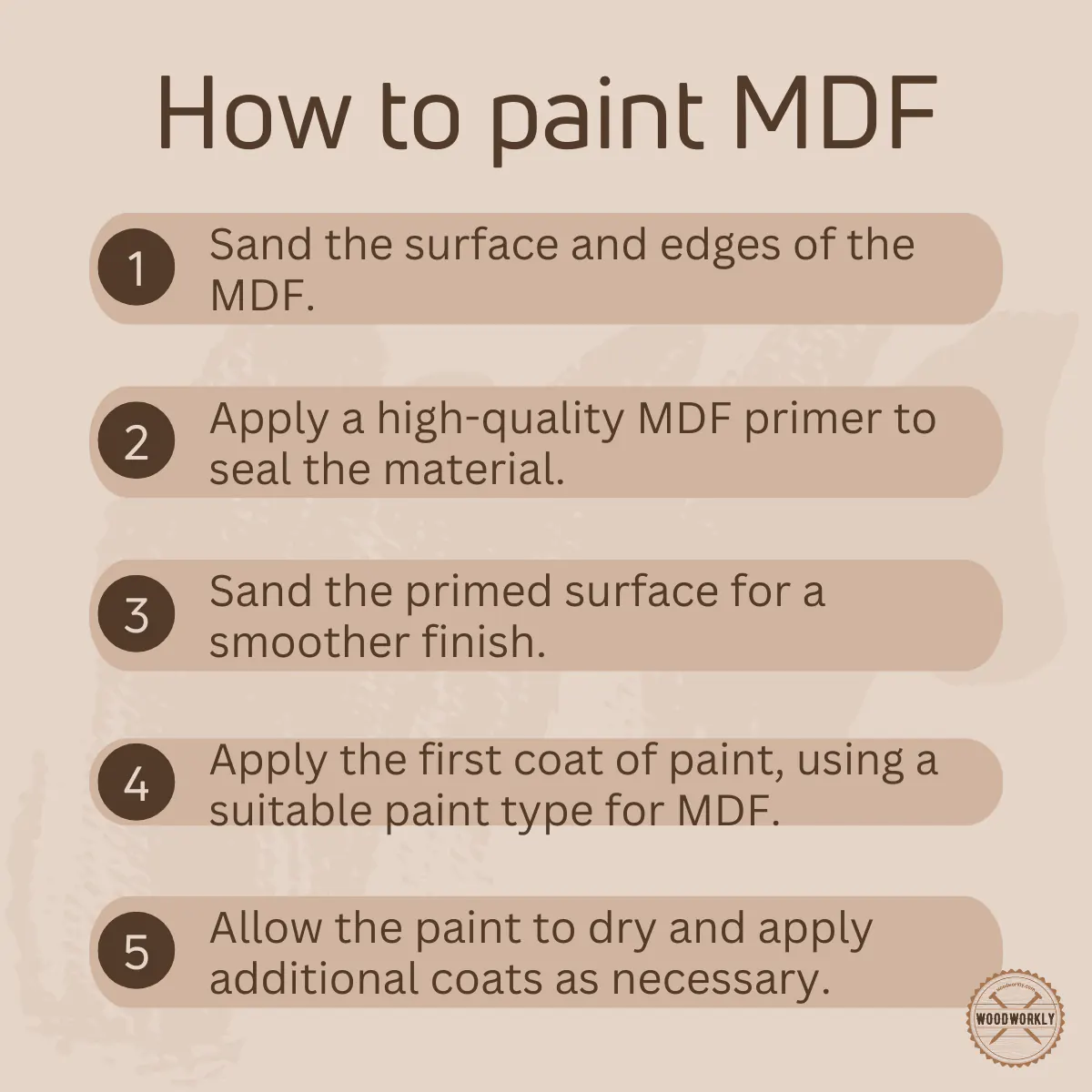Ever wondered if you can give your MDF furniture a fresh, new look with paint? Let’s dive into the world of possibilities and explore the dos and don’ts together!

Did you feel unhappy about your MDF furniture because it was wearing down, becoming chipped, dingy, or dated-looking?
Don’t worry; I had the same concerns a long time ago and found answers thanks to the experts I met during my vacation in Alaska in mid-2018.
You can still repaint them and continue to use them for a long time.
Now, with years of experience working as a woodworker, I am here to teach you how to properly repaint MDF furniture.
So, let’s find out, can you paint on MDF?
Yes, you can paint MDF with proper preparation. Sand the surface, apply a suitable primer, and use oil-based or water-based paints. Ensure the edges are well-sealed to prevent absorption and achieve a smooth finish. Work in a ventilated area and use safety gear for protection.
But there’s a lot more to know.

I’ll bring you more detailed information for each step of painting MDF with expert techniques and many more.
Plus I’ll share very important tips that I’ve learned so far as a woodworker for promising results.
Let’s jump in!

Can You Paint Straight on MDF?
Yes, you can paint straight on MDF. MDF is readily paintable. But don’t expect it to last long. When it is knocked or scratched, the paint will probably chip or come off.
Due to the lack of sealing of bare MDF, the paint will spread unevenly and quickly into the porous surface, giving the paint a streaky, patchy appearance and a weak paint bond.
What is MFD?
MDF, Medium Density Fiberboard is a common form of inexpensive engineered wood product which is utilized in a variety of building and woodworking applications.
MDF is made from a mixture of wood fibers, wax, and resin that has been fired, compacted, and then heated again to make a sheet that is uniformly dense, and smooth.

Properties of MFD
MDF has a very smooth and level surface, making it perfect for uses like cabinet doors, furniture, and interior trim where a flat and constant surface is necessary.
- Stability
It is less likely to warp or split than natural wood because of its solid and uniform composition.
- Interior Use
The primary use of MDF is in interior applications. Because it might swell and decay when exposed to moisture, it is not ideal for outdoor or damp areas.
- Thickness Variations
MDF sheets are available in a variety of thicknesses, often ranging from 1/4 inch to 1 inch or more, giving designers and builders more versatility.
- Versatile
MDF is incredibly versatile and is simple to cut, shape, and paint. Numerous items, like furniture, cabinetry, decorative wall panels, and more, can be made with it.
- Budget-friendly
It is frequently less expensive than solid wood or other engineered wood products, making it a wise choice for many applications.
Read to know, Painting Engineered Wood (6-Step EASY Guide!)
- Edge Sealing
MDF edges may need to be edge sealed with a primer or wood filler because they are more porous, in order to avoid an inconsistent paint finish.
MDF is a flexible material, but because it lacks the natural grain and feel of wood and can be susceptible to moisture, it requires careful preparation before painting.

Factors You Need to Consider When Painting MDF
There are several crucial things to take into account while painting MDF in order to get the best results.
Here are the key factors to keep in mind when painting MDF,
Primer Selection
MDF can be painted without a primer, but doing so can result in uneven paint absorption, which can be avoided by using a high-quality MDF primer made specifically for this material.
The quantity of paint coats needed might be decreased with the use of a primer.
Paint Selection
Select a paint that is appropriate for MDF. Acrylic and latex paints stick well to MDF and dry rather rapidly makes them popular.
Enamel paints can offer a more durable finish.
Edge Sealing
Because MDF edges are more porous, edge sealing with a primer or wood filler may be necessary to avoid an uneven paint finish.

What Kind of Paint Do You Use on MDF?
The best paints to use on MDF are Acrylic paint, Enamel paint and Spray paint.
So, let’s talk about those paints in detail.
Acrylic Paint
Because of its excellent adherence, quick drying time, and simplicity of usage, acrylic paint is a popular choice for painting MDF.

It is offered in a vast array of hues and textures, such as matte, satin, and glossy. Acrylic paints can be used for a variety of MDF applications, including crafts, wall panels, and furniture.
Enamel Paint
Oil- or water-based enamel paints are known for their durability and long-lasting finish.

For MDF projects requiring a high level of durability, such as kitchen cabinets, doors, and trim, water-based enamel paints are used.
Although less popular for MDF, oil-based enamel paints can be utilized in some circumstances.
Spray Paint
Whether it’s acrylic or enamel, spray paint can be a useful tool for uniformly coating and smoothing up MDF surfaces.

It’s a fantastic option for tasks like crafting, manufacturing smaller products, or building models out of MDF.
Read to know, How to Get Spray Paint Off Wood? (14 EASY Ways!)
Supplies You Will Need When Painting MDF
Before starting the process gather below mentioned all the tools and materials below.
Equipment / Tools
- MDF surface to be painted
- Safety gear (protective eyewear, dust mask, gloves)
- Sandpaper (120 to 220 grit)
- Paintbrush
Materials
- Paint
- Polymer-based filler
- Solvent-based primer
- Tack cloth
- Clear topcoat or sealer
Tip: If you couldn’t find tack cloths, here are some alternatives to tack cloth.
Collect the above supplies from quality manufacturers and get ready for the paint job of MDF.

How to Paint MDF?
To obtain a clean and professional finish when painting MDF, careful preparation and the proper technique are necessary.
Here is a detailed instructions on how to successfully paint MDF.
1. Safety first
Always wear protective eyewear and a tight-fitting dust mask when sanding MDF since the fine dust can irritate the eyes and lungs.
Use the proper safety equipment, such as gloves, safety glasses, and a mask to protect yourself from fumes and particles, when working with paints and primers.
2. Surface Preparation
The first step is to seal the edges of the MDF board because they are more porous than the surface and need to be smooth in order to adequately take the paint.
Apply proper sealant to the edges of the MDF and let it dry. You can use acrylic paint sealer, PVA wood glue, joint compound, and drywall compound as sealants.
Apply wood filler compound to any minor holes, cracks, or faults in the MDF and let it dry completely according to the manufacturer’s instructions.
Carefully smooth the surface level with the surrounding area after it has cured.
Use 220 grit sandpaper to smooth and even out the edges after the compound has completely dried.
Then, using fine-grit sandpaper to smooth up the MDF surface remove any wax covering, and level out any high spots or other abnormalities.
Use a clean cloth to remove extra dirt from the MDF’s surface. You can use a vacuum to gather up the extra dust created by sanding.

3. Priming
Using an MDF primer will result in a more attractive finish since it stops the MDF from absorbing the paint.
If you have already painted and sealed MDF, you do not need to prime it before painting; instead, you can begin painting right away with the first coat.
Make sure to use a solvent-based primer; oil-, alcohol-, or lacquer-based primer because the water-based primer will soak into the MDF and cause it to expand and will ruin your project.
Using a paintbrush, roller, or spray gun, evenly coat the MDF board with a thin layer of primer, paying close attention to the edges and corners.
The choice of applicator depends on the size of the project: use a paintbrush for small ones and paint rollers or sprayers for large projects.
Read to know, How Many Coats Of Primer On Wood? For Perfect Finish!
4. Paint Application
It’s time to apply the paint.
After the primer has dried, apply the desired paint; an oil-based paint is compatible with the solvent-based primer and if needed you can use paint thinner which is a non-water to thin it.
Make sure you have the right color, then open the can and, if required, mix it.
Again, the project determines the application tool’s size, uses a foam roller for bigger projects, and uses a paintbrush for small objects. Make sure to apply an even thin coat.
If the first coat of paint seems dry to the touch, decide whether a second coat is necessary. The entire MDF project should be painted again if you see any patchiness.
5. Drying and Curing
Allow the paint to dry thoroughly. Before handling the MDF, let the last coat of paint thoroughly dry and cure.
Consult the guidelines provided by the paint manufacturer as curing durations can vary based on the type of paint you use.
Read to know, Does Paint Dry Darker or Lighter? (Here’s the Truth!)
6. Sealing (Optional)
If you need to add further durability and protection, add a clear topcoat or sealer to the paint.
A further layer of protection can be gained by varnish, polyurethane, or acrylic sealants.
For this, follow the application and drying time recommendations provided by the manufacturer.
7. Clean Up
Place your materials away and check that the wood doesn’t have any extra paint or wood sticking off of it.
If there are, lightly sand them and use touch-up paint to fix them.
After painting is done, check out How to Clean Acrylic Paint Brushes? (EASY Guide!)
That’s it folks! Now you know if can you paint MDF and how it should be done!

Now I’m going to share with you several tips that I’ve learned while I was painting MDF furniture and woodwork for a long time.
The below tips will take your MDF paint job to the next level without any issues.
Some of the below tips were collected from the expert woodworkers in Alaska I met during my vacation days.
Just keep reading!
Tips for Painting MDF
- You must be careful to sand lightly. With uncoated MDF, excessive pressure will lead to damage. Painting becomes difficult because of this damage, which causes adherence problems.
- Make sure the last coat has completely dried before adding a new one. If not, it may require more time than usual for the numerous applications to completely dry.
- You can softly sand between applications using extremely fine-grit sandpaper (like 400-grit), for an especially flawless finish. Be careful not to sand through the paint layers.
- Because MDF is porous, it’s crucial to keep in mind that you could need more paint than you think.
- When applying the paint and primer, always back brush to get rid of the roller marks for a flawless finish.
- You may use paint thinner to thin the first coat by 10-15% to avoid a blotchy topcoat and use oil-based primers instead of water-based primers because they seal better and help minimize bloating.
- You need to buy a high-quality brush that can hold more paints and for fewer brush strokes. Furthermore, you can reduce brush strokes by spraying paint horizontally or brush or roll paint vertically.
- If there are imperfections on your flat surface, choose a protective layer that gives a satin or semi-gloss sheen.
- MDF that is sealed and filled cannot be stained. Only painting will work.
Benefits & Drawbacks of MDF
MDF offers both advantages and disadvantages. Knowing these can assist you to choose for correct project.
Pros
- A smooth surface is not disturbed by knots or kinks in medium-density fiberboard.
- Due to the chemicals used in its production, MDF is resistant to some insects.
- Due to its composition, the wood has no visible grain and a uniform look.
- Compared to a natural wood surface, it is less volatile to movement, which helps minimize paint cracking.
Cons
- Without the grain, it lacks the texture that many people need when staining wood.
- MDF is not as strong as solid wood. So, MDF furniture is more vulnerable to breaking or warping than solid-wood furniture.
- Can crack or split under extreme stress.
- Since it more readily absorbs water than wood, if MDF furniture becomes wet it is more likely to swell or change shape.
- Due to the high density of MDF, it may fracture if fasteners like screws or nails are used to secure it.
- Contains volatile organic compounds (VOCs)
How To Seal Mdf Before Painting
- To guarantee that the paint adheres well and that the surface has a uniform finish, sealing MDF before painting is an essential step.
- Make sure the surface is free of any dust and debris.
- Apply a water-based wood sealant or MDF primer and allow it to dry completely.
- You can lightly sand the sealed surface with very fine-grit sandpaper (like 400-grit) and apply the paint. This procedure might aid in preparing a surface for painting that is more smooth.
How Long Does Paint Last on MDF
The durability of paint on MDF depends on the quality of the paint and primer, the environmental conditions to which the MDF is exposed, and how thoroughly the surface was prepared.
Generally, properly applied and maintained paint on MDF can survive for many years.
How to Maintain Painted MDF
Check the painted MDF occasionally for any signs of wear or damage. Regular touch-ups and repairs can help the paint last longer.
To avoid a buildup of dirt, regularly dust the surface with a soft, lint-free cloth, microfiber cloth, or a duster.
Use a moist towel or sponge with mild, soapy water for more thorough cleaning jobs. Avoid using aggressive cleaning agents or abrasive chemicals on the paint or finish.
So, let’s answer some frequently asked questions.
FAQs
What is MDF and can it be painted?
MDF stands for Medium-Density Fibreboard, a popular material used in furniture and building materials due to its combination of sawdust and resins. Yes, MDF can be painted, but it requires proper preparation and the use of suitable paint.
How do I prepare MDF for painting?
Prepare MDF for painting by sanding its surface with 150 grit sandpaper, and pay special attention to the edges, which are rougher and more porous. Applying a suitable primer, like Dulux Trade Quick Dry MDF Primer, is crucial for creating a uniform substrate ready for painting.
What are the benefits of painting MDF?
MDF provides a smooth surface for painting due to its small fibres and has a uniform appearance since it lacks visible wood grain. It is less prone to movement, reducing the risk of paint cracking.
Are there any drawbacks to painting MDF?
MDF can produce a lot of dust when sanded or sawed, necessitating appropriate safety gear. Its porous nature can lead to water absorption, making oil-based paints a recommended choice, although water-based paints can be used if the MDF is properly primed and sealed.
What is the best type of paint to use on MDF?
For a smooth finish on MDF, oil-based paints are preferred as they adhere well to the surface, although water-based paints can also be used if the MDF is adequately sealed and primed. Crown Trade Fast Flow QD Satin is recommended for use over a water-based primer.
Can I use water-based paint on MDF?
Yes, water-based paint can be used on MDF, but it must be properly primed and sealed beforehand to prevent issues related to the material’s porosity.
How do I achieve a smooth finish when painting MDF?
For a smooth finish, use a foam roller to apply paint on large MDF surfaces, and ensure that both the surface and edges of the MDF have been properly sealed and primed.
What safety precautions should I take when painting MDF?
Ensure you are working in a well-ventilated area, wear latex gloves, and use breathing protection when sanding MDF to safeguard against dust and fumes from paints and coatings.
Can I stain MDF instead of painting it?
MDF lacks the grain texture that many people desire when staining wood, and its porous nature makes it unsuitable for staining. Sealed and filled MDF cannot be stained; it can only be painted.
What tools and materials do I need to paint MDF?
To paint MDF, you will need tools like rollers, brushes, a putty knife, a sanding block, and potentially an oscillating sander. Materials needed include paint, sanding sealer, polymer-based filler, sandpaper, and a paint tray.
Did I cover all you wanted to know about: Can You Paint On MDF
In this article, I deeply discussed can you paint MDF and how to paint MDF using a fast and easy method that I have practiced for more than 3 years.
To paint MDF, first, you need to prepare the surface by sanding it down, adding a layer of sanding sealer, applying a coat of primer, and then applying a coat of paint on it. Make sure to select primer and paint appropriately and lightly sand between all coats for best results.
Furthermore, I’ve answered some frequently asked questions as well.
Hope you learned everything you wanted to know about, painting on MDF including expert tips!
Now it is time for you to Give it a try and enhance the look of your MDF product. Happy wood finishing!